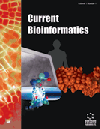- Home
- A-Z Publications
- Current Bioinformatics
- Previous Issues
- Volume 19, Issue 8, 2024
Current Bioinformatics - Volume 19, Issue 8, 2024
Volume 19, Issue 8, 2024
-
-
A Novel Natural Graph for Efficient Clustering of Virus Genome Sequences
More LessAuthors: Harris Song, Nan Sun, Wenping Yu and Stephen S.-T. YauBackground: This study addresses the need for analyzing viral genome sequences and understanding their genetic relationships. The focus is on introducing a novel natural graph approach as a solution. Objective: The objective of this study is to demonstrate the effectiveness and advantages of the proposed natural graph approach in clustering viral genome sequences into distinct clades, subtypes, or districts. Additionally, the Read More
-
-
-
Identification of Mitophagy-Related Genes in Sepsis
More LessAuthors: Xiao-Yan Zeng, Min Zhang, Si-Jing Liao, Yong Wang, Ying-Bo Ren, Run Li, Tian-Mei Li, An-Qiong Mao, Guang-Zhen Li and Ying ZhangBackground: Numerous studies have shown that mitochondrial damage induces inflammation and activates inflammatory cells, leading to sepsis, while sepsis, a systemic inflammatory response syndrome, also exacerbates mitochondrial damage and hyperactivation. Mitochondrial autophagy eliminates aged, abnormal or damaged mitochondria to reduce intracellular mitochondrial stress and the release of mitochondria-assoc Read More
-
-
-
Optimized Hybrid Deep Learning for Real-Time Pandemic Data Forecasting: Long and Short-Term Perspectives
More LessAuthors: Sujata Dash, Sourav K. Giri, Subhendu Kumar Pani, Saurav Mallik, Mingqiang Wang and Hong QinBackground: With new variants of COVID-19 causing challenges, we need to focus on integrating multiple deep-learning frameworks to develop intelligent healthcare systems for early detection and diagnosis. Objective: This article suggests three hybrid deep learning models, namely CNN-LSTM, CNN-Bi- LSTM, and CNN-GRU, to address the pressing need for an intelligent healthcare system. These models are designed to ca Read More
-
-
-
Transformer-based Named Entity Recognition for Clinical Cancer Drug Toxicity by Positive-unlabeled Learning and KL Regularizers
More LessAuthors: Weixin Xie, Jiayu Xu, Chengkui Zhao, Jin Li, Shuangze Han, Tianyu Shao, Limei Wang and Weixing FengBackground: With increasing rates of polypharmacy, the vigilant surveillance of clinical drug toxicity has emerged as an important concern. Named Entity Recognition (NER) stands as an indispensable undertaking, essential for the extraction of valuable insights regarding drug safety from the biomedical literature. In recent years, significant advancements have been achieved in the deep learning models on NER tasks. Nonethe Read More
-
-
-
Inferring Gene Regulatory Networks from Single-Cell Time-Course Data Based on Temporal Convolutional Networks
More LessAuthors: Dayu Tan, Jing Wang, Zhaolong Cheng, Yansen Su and Chunhou ZhengBackground: Time-course single-cell RNA sequencing (scRNA-seq) data represent dynamic gene expression values that change over time, which can be used to infer causal relationships between genes and construct dynamic gene regulatory networks (GRNs). However, most of the existing methods are designed for bulk RNA sequencing (bulk RNA-seq) data and static scRNA-seq data, and only a few methods, such as CNNC Read More
-
-
-
Identification of Spatial Domains, Spatially Variable Genes, and Genetic Association Studies of Alzheimer Disease with an Autoencoder-based Fuzzy Clustering Algorithm
More LessAuthors: Yaxuan Cui, Leyi Wei, Ruheng Wang, Xiucai Ye and Tetsuya SakuraiIntroduction: Transcriptional gene expressions and their corresponding spatial information are critical for understanding the biological function, mutual regulation, and identification of various cell types. Materials and Methods: Recently, several computational methods have been proposed for clustering using spatial transcriptional expression. Although these algorithms have certain practicability, they cannot utilize spatial infor Read More
-
-
-
Network Subgraph-based Method: Alignment-free Technique for Molecular Network Analysis
More LessAuthors: Efendi Zaenudin, Ezra B. Wijaya, Venugopal R. Mekala and Ka-Lok NgBackground: Comparing directed networks using the alignment-free technique offers the advantage of detecting topologically similar regions that are independent of the network size or node identity. Objective: We propose a novel method to compare directed networks by decomposing the network into small modules, the so-called network subgraph approach, which is distinct from the network motif approach because it doe Read More
-
Volumes & issues
-
Volume 20 (2025)
-
Volume 19 (2024)
-
Volume 18 (2023)
-
Volume 17 (2022)
-
Volume 16 (2021)
-
Volume 15 (2020)
-
Volume 14 (2019)
-
Volume 13 (2018)
-
Volume 12 (2017)
-
Volume 11 (2016)
-
Volume 10 (2015)
-
Volume 9 (2014)
-
Volume 8 (2013)
-
Volume 7 (2012)
-
Volume 6 (2011)
-
Volume 5 (2010)
-
Volume 4 (2009)
-
Volume 3 (2008)
-
Volume 2 (2007)
-
Volume 1 (2006)
Most Read This Month
Article
content/journals/cbio
Journal
10
5
false
en


